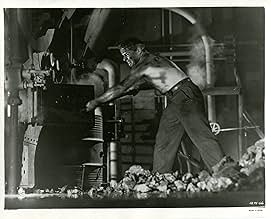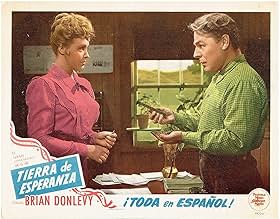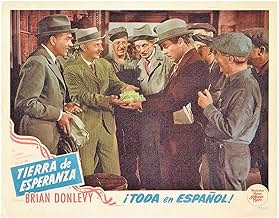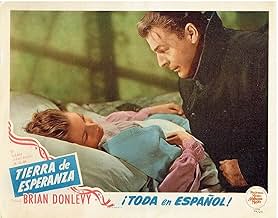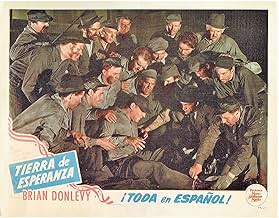NOTE IMDb
6,7/10
641
MA NOTE
Ajouter une intrigue dans votre langueStefan Dangos, an immigrant, starts working in iron mines and steel mills. Through hard work, he rises through the ranks, eventually becoming a successful American industrialist.Stefan Dangos, an immigrant, starts working in iron mines and steel mills. Through hard work, he rises through the ranks, eventually becoming a successful American industrialist.Stefan Dangos, an immigrant, starts working in iron mines and steel mills. Through hard work, he rises through the ranks, eventually becoming a successful American industrialist.
- Réalisation
- Scénario
- Casting principal
- Récompenses
- 2 victoires au total
Stephen McNally
- Teddy Roosevelt Dangos
- (as Horace McNally)
- …
Ernie Adams
- Man and Dog Act
- (non crédité)
Fred Aldrich
- Assembly Line Worker
- (non crédité)
Axel Anderson
- Immigrant
- (non crédité)
King Baggot
- Graduation Ceremony Attendee
- (non crédité)
Charles Bates
- Teddy Roosevelt Dangos - Age 8
- (non crédité)
Barbara Bedford
- Hospitable Farm Woman
- (non crédité)
Arthur Belasco
- Drowsy Miner
- (non crédité)
Leon Belasco
- Cigar Store Proprietor
- (non crédité)
Art Berry Sr.
- Customs Man
- (non crédité)
Anna Marie Biggs
- Girl Soprano
- (non crédité)
Avis à la une
Wonderful shots of ca 1940 industry. The iron mine and ore docks were beautifully done, the open hearth and rolling mill was also great. Loved the Plymouths re-badged as "Dantons", apparently these were '41 leftovers as passenger car production was halted during the war. But the credits say the airplane factory was Douglas, some of the close ups of the Rosie the riveters may have been Douglas, but surely the B-17 line was at a Boeing plant? Or did Douglas also build B-17s?
But the drama was kind of corny. Not that immigrants didn't or couldn't become industrialists, but I don't think GMs steel turret tops cars could possibly have been invented in a backyard shed. In 1910 an innovative individual might have made a real improvement in auto production; by the thirties this could only have been done by a large industrial firm like GM with millions of dollars and hundreds of engineers.
But the drama was kind of corny. Not that immigrants didn't or couldn't become industrialists, but I don't think GMs steel turret tops cars could possibly have been invented in a backyard shed. In 1910 an innovative individual might have made a real improvement in auto production; by the thirties this could only have been done by a large industrial firm like GM with millions of dollars and hundreds of engineers.
I taped this movie and just got around to watching it. As a senior, I was delighted to watch an old fashioned drama of bygone days and I thought Brian Donlevy did a great job. This man never got the recognition he deserved often cast in unfavorable roles. "An American Romance" gave him the opportunity to excel and he did a great job. I realize it is a Rags to Riches story and from the standpoint of contemporary society, a bit "corny", but it nonetheless had a message that hard work and dedication leads to success and happiness.
My only criticism is that it ended too abruptly. I did not watched the 151 minute version. T.C.M. showed a shorter version but I felt ending with world war II and building planes was a bit of a disappointment.
If you are looking for a film to show your grandchildren, this is it!
My only criticism is that it ended too abruptly. I did not watched the 151 minute version. T.C.M. showed a shorter version but I felt ending with world war II and building planes was a bit of a disappointment.
If you are looking for a film to show your grandchildren, this is it!
"An American Romance" from 1944 is partly propaganda and partly about immigrants who came to this country and went for the American dream. Originally, the stars were to be Spencer Tracy and Ingrid Bergman instead of Brian Donlevy and Ann Richards, which would have made it seem like a much bigger film. King Vidor thought he had an agreement that Tracy and Bergman would star; apparently MGM heard something else. As it is, the film is done in color and had a good budget.
The version I saw is 121 minutes; originally the film was 150 minutes and the studio ordered 30 minutes cut. There are long scenes of factory work as iron, steel, cars, and airplanes are produced, and Vidor thought the 30 minutes would come from those scenes, which are wonderful but plentiful. Instead dramatic portions were cut. The film ends abruptly.
Need I add, this was the last film King Vidor did for MGM.
The story concerns a Czech, Stefan Dangos, who emigrates to America, intending to get a job in the iron mines with his cousin. That happens, and he works his way up, along the way marrying his English tutor (Ann Richards). He graduates to steel, and finally goes into business making cars.
This is truly a story about achieving the American dream, with a lot of patriotism thrown in, as the film spans from the 1890s into World War II and America's entry into it.
The factory scenes and the scenes in the iron mines are fascinating. Of note, during World War II, there were no passenger car assembly lines in operation. As a result, Vidor had to borrow cars from Chrysler, take them apart, and reassemble them in a simulated assembly line.
Brian Donlevy, who usually plays the heavy, does a fine job here. He's no Spencer Tracy, but I liked him in the role. He's rough around the edges and very believable and likable. Ann Richards is lovely as his wife - I assume if Ingrid Bergman had done this role, it would have been built up quite a bit. Stephen McNally and Walter Abel are also featured; McNally, as one of Stefan's son, is the narrator.
Good, not great, but certainly an interesting film.
The version I saw is 121 minutes; originally the film was 150 minutes and the studio ordered 30 minutes cut. There are long scenes of factory work as iron, steel, cars, and airplanes are produced, and Vidor thought the 30 minutes would come from those scenes, which are wonderful but plentiful. Instead dramatic portions were cut. The film ends abruptly.
Need I add, this was the last film King Vidor did for MGM.
The story concerns a Czech, Stefan Dangos, who emigrates to America, intending to get a job in the iron mines with his cousin. That happens, and he works his way up, along the way marrying his English tutor (Ann Richards). He graduates to steel, and finally goes into business making cars.
This is truly a story about achieving the American dream, with a lot of patriotism thrown in, as the film spans from the 1890s into World War II and America's entry into it.
The factory scenes and the scenes in the iron mines are fascinating. Of note, during World War II, there were no passenger car assembly lines in operation. As a result, Vidor had to borrow cars from Chrysler, take them apart, and reassemble them in a simulated assembly line.
Brian Donlevy, who usually plays the heavy, does a fine job here. He's no Spencer Tracy, but I liked him in the role. He's rough around the edges and very believable and likable. Ann Richards is lovely as his wife - I assume if Ingrid Bergman had done this role, it would have been built up quite a bit. Stephen McNally and Walter Abel are also featured; McNally, as one of Stefan's son, is the narrator.
Good, not great, but certainly an interesting film.
First take note of the date of this movie ( the forties) because we still had the mindset to be grateful and that was a time where people all over the world wanted to immigrate here. Not knowing what to expect, having little or no money and not speaking English they knew if they can get here the rest would come and it did for tens of millions of people. This is displayed quite well in this movie. I enjoyed Brian Donlevy and I kept waiting for him to trip up on his foreign accent but he was too good an actor to do so. This is an every man who only knows hard honest work and because of that does very well winning over people, making a buck, climbing the success ladder and even purchasing a home. Great scenes of family and traditions too. The war enters into the picture with Pearl Harbor and we are introduced to joining the military to defend and fight back as well as Rosie the riveter (women work forces) and what was Americas strongest points i.e. manufacturing and coming together as a nation. We could turn out volume on anything we chose such as planes, ammo, guns, etc. We ended up not only giving and selling planes to help Russia and others but also let many just end up in huge junk yards across the nation after the war ended. America could do no wrong and our main character proves that point over and over through tragedy and triumph. It starts out a little slow but necessary to make the points and then delivers a nice satisfactory viewing for your time and attentions given. Good movie to eat a meal by, have a tasty drink and a leisurely snack or two. Make sure to take note of the automobile industry in its infancy and the designs of the cars too. Also note that they sold cars from orders taken at car show annually. Fascinating bits of little history here and there. Enjoy
I saw this movie as a nine year old child and never forgot it. Later it appeared on television and more recently on TCM. I was impressed by the hero's fortitude in walking to Minnesota to join his cousin at the Mesabe Iron Range, his hard work, and his learning to read and eventually marrying the teacher. Each of his male children was named for a president after a friend remarked their child might reach that office. The movie taught me how iron ore was shipped east and processed into steel. Dangos also moves east and becomes a foreman. He eventually becomes an automobile manufacturer and his new ideas bring him success. His children succeed by achieving through the benefits of education. The movie ends after a documentary of American industry's contribution to the war effort. The Technicolor was gorgeous and Donlevy's performance believable. I still enjoy watching this film and believe King Vidor put his heart into it.
Le saviez-vous
- AnecdotesDuring World War II, there were no passenger car assembly lines in operation. As a result, Vidor had to borrow cars from Chrysler, take them apart and re-assemble them in a simulated assembly line. Seen emerging from the factory are 1942 Plymouths with a Danton insignia and hubcaps. These were the last passenger cars manufactured by Chrysler before the World War II shutdown.
- GaffesAs Steve Dangos closes his front door (after arriving home from the board meeting), a hand and lower arm can also be seen closing the door from the outside.
- Versions alternativesOriginal version premiered at 151 minutes; later cut to 122 minutes.
- Bandes originalesAmerica, My Country Tis of Thee
(1832) (uncredited)
Music by Lowell Mason, based on the Music by Henry Carey from "God Save the King" (1744)
Played during the opening credits
Reprised at the end
Meilleurs choix
Connectez-vous pour évaluer et suivre la liste de favoris afin de recevoir des recommandations personnalisées
Détails
Box-office
- Budget
- 3 000 000 $US (estimé)
- Durée
- 2h 31min(151 min)
- Rapport de forme
- 1.37 : 1
Contribuer à cette page
Suggérer une modification ou ajouter du contenu manquant


